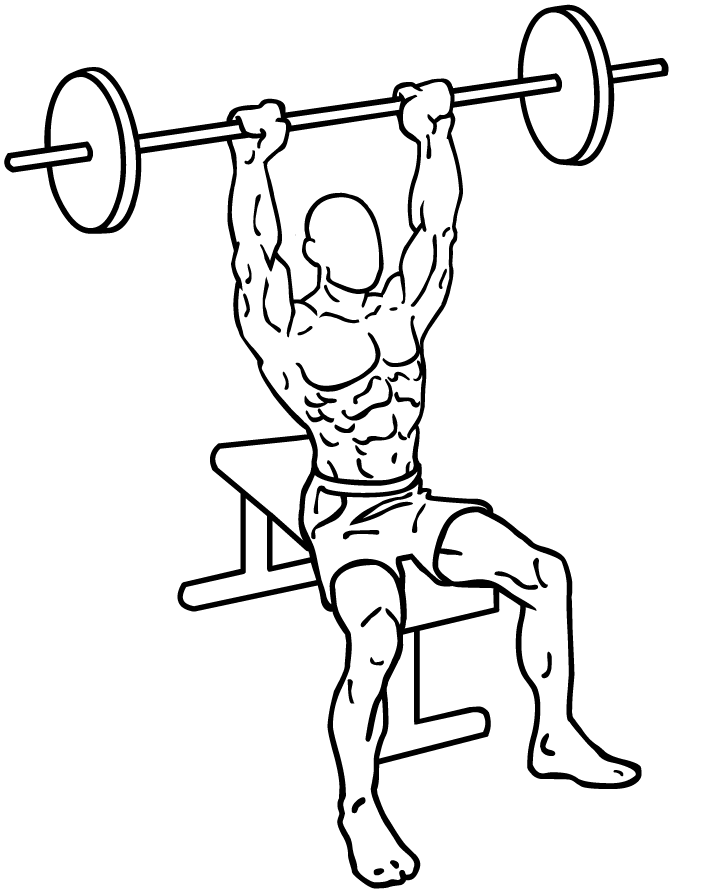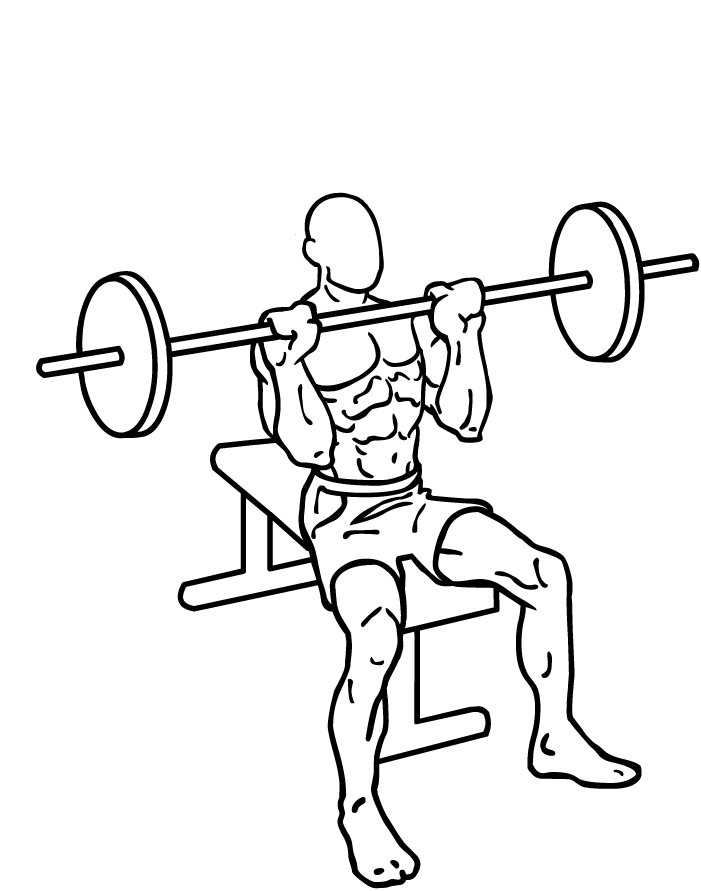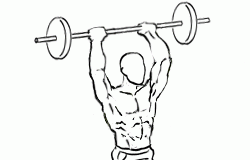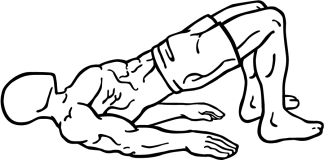Last Updated on September 26, 2014
The Seated Barbell Shoulder Press, also known as the Seated Military Shoulder Press, is a powerhouse exercise for building strength in the shoulders, chest, and triceps. It’s one of the best compound movements for upper body development, suitable for anyone looking to improve their physique, functional strength, or sports performance.
In this blog, we’ll dive deep into the benefits, detailed steps, variations, common mistakes, and tips for safe and effective execution.
Why Choose the Seated Barbell Shoulder Press?
The Seated Barbell Shoulder Press is an exercise that provides multiple benefits:
- Shoulder Strength and Size: It primarily targets the deltoid muscles, helping to build stronger and more defined shoulders.
- Triceps Activation: By extending the arms overhead, the exercise also involves the triceps, contributing to overall arm strength.
- Upper Chest Engagement: The upper chest muscles assist during the lift, making this a great exercise for upper body conditioning.
- Improved Posture: With the correct form, the exercise encourages better posture by reinforcing the shoulders and upper back muscles.
Muscles Worked
The Seated Barbell Shoulder Press effectively targets:
- Deltoids (Shoulders): The primary muscle group, involved in raising and stabilizing the arms.
- Triceps: Extend the elbows, assisting in pressing the weight overhead.
- Upper Pectorals: The upper portion of the chest muscles aids in lifting.
- Trapezius and Upper Back: Help stabilize the shoulders and keep proper posture.
Step-by-Step Guide to Performing the Seated Barbell Shoulder Press
To get the most out of the Seated Barbell Shoulder Press, follow these steps to ensure proper form and avoid injury.
Equipment Needed:
- Barbell and weight plates
- Bench with an adjustable rack for shoulder-level support
Steps:
- Set Up Your Bench and Weights: Position a bench under a barbell rack with the bar set at shoulder height. Choose a weight that is challenging but manageable for your level.
- Grip the Barbell: Sit on the bench with feet flat on the floor. Grasp the barbell with your hands about 3–4 inches wider than shoulder-width apart, using an overhand grip.
- Lift and Position the Barbell: Lift the bar off the rack, keeping your back straight and core engaged. Hold the barbell just above your shoulders, with elbows bent and slightly forward.
- Execute the Press: Push the bar up overhead in a controlled motion, extending your arms without locking the elbows at the top. Focus on keeping your shoulders engaged and your spine neutral.
- Pause and Lower: Pause briefly at the top, then slowly lower the bar to shoulder height in a controlled manner, resisting the weight as it descends.
- Repeat: Perform the desired number of reps, ensuring each movement is controlled and intentional.
Form and Technique Tips
Maintaining proper form is crucial to preventing injury and maximizing effectiveness:
- Keep Your Core Tight: Engaging your core throughout the lift prevents the lower back from arching and stabilizes the upper body.
- Avoid Locking Elbows: Fully extending your arms without locking the elbows protects the joints and keeps tension on the muscles.
- Maintain Good Posture: Sit up straight with a slight natural arch in your back, and avoid leaning back excessively.
Common Mistakes to Avoid
While the Seated Barbell Shoulder Press is straightforward, there are common mistakes that can impact your results and increase the risk of injury:
- Arching the Lower Back: Leaning too far back can put undue pressure on the lower back. Maintain a neutral spine by engaging the core and keeping the back flat against the bench.
- Using Too Much Weight: Using a weight that’s too heavy leads to poor form, excessive swinging, and potential injury. Start with a manageable weight, then increase gradually.
- Poor Elbow Position: Keep elbows slightly forward rather than flaring them out to the sides, which can strain the shoulder joints.
- Moving Too Quickly: Rushing through the lift reduces muscle engagement and control. Slow, deliberate movements are key to effective muscle engagement.
Safety Tips
- Avoid if Injured: Skip this exercise if you have existing shoulder, elbow, or wrist pain, as it can exacerbate these issues.
- Warm Up First: Perform shoulder mobility and light stretching before heavy lifting to prepare the joints and muscles.
- Spotter or Safety Rack: If you’re lifting heavier weights, consider using a spotter or safety rack to prevent accidents.
Variations of the Seated Barbell Shoulder Press
Incorporating variations can keep your workout fresh and challenge your muscles in new ways:
1. Dumbbell Shoulder Press
Performing the press with dumbbells instead of a barbell can help improve balance and engage the stabilizer muscles more effectively. It also allows for a greater range of motion, which can be beneficial for muscle activation.
Steps:
- Hold a dumbbell in each hand and follow the same pressing motion.
- This variation can also be performed seated or standing for additional challenge.
2. Standing Military Press
The standing version engages the entire body, especially the core and lower back, as you press the weight overhead. It’s a great variation for athletes who want to improve functional strength.
Steps:
- Stand with feet hip-width apart, gripping the barbell as you would in the seated version.
- Keep your core tight and maintain good posture as you press overhead.
3. Smith Machine Shoulder Press
Using a Smith machine provides extra stability, as the bar is guided on rails. This can be helpful for beginners who want to focus on form without worrying about balance.
Steps:
- Position the bench under the Smith machine, set the bar to shoulder height, and follow the same pressing movement.
4. Behind-the-Neck Shoulder Press (Advanced)
This is an advanced variation that shifts focus to the rear deltoids. However, it’s only recommended for individuals with healthy, flexible shoulders due to the increased strain on the joints.
Steps:
- Instead of pressing the bar in front of you, lower it behind your head, then press back up.
- Make sure to use lighter weights and perfect form for this variation.
Incorporating the Seated Barbell Shoulder Press into Your Workout Routine
This exercise can be used in different types of training routines, depending on your fitness goals:
- Strength Training: Aim for 4–6 reps with a heavier weight to build strength.
- Hypertrophy (Muscle Growth): Use a moderate weight for 8–12 reps to promote muscle growth.
- Endurance and Toning: Use lighter weights and aim for 15–20 reps if your goal is muscle endurance and definition.
For balanced shoulder development, consider pairing the Seated Barbell Shoulder Press with other shoulder exercises like lateral raises, face pulls, and rear delt flys. This well-rounded approach will engage all three parts of the deltoids for better overall growth.
Sample Shoulder Workout Routine
For a balanced shoulder day, try this routine:
- Seated Barbell Shoulder Press – 4 sets of 8–10 reps
- Dumbbell Lateral Raises – 3 sets of 12–15 reps
- Rear Delt Flys – 3 sets of 12–15 reps
- Front Raises with Dumbbells – 3 sets of 10–12 reps
This workout targets each area of the shoulder, ensuring balanced development and increased strength.
Progression and Increasing Difficulty
Progression is essential for continued gains. Here’s how you can gradually increase the difficulty:
- Add Weight: Slowly increase the weight as you build strength.
- Increase Volume: Add more sets or reps to your routine.
- Use a Slower Tempo: Slowing down each phase of the lift will enhance muscle activation.
Shoulder Press and Functional Fitness
The Seated Barbell Shoulder Press is not only great for building muscle; it also has functional benefits. Strengthening the shoulders improves posture, makes everyday tasks easier, and boosts athletic performance.
Benefits of Seated Barbell Shoulder Press vs. Other Shoulder Exercises
Compared to other shoulder exercises, the Seated Barbell Shoulder Press offers several unique advantages:
- Compound Movement: Engages multiple muscles simultaneously, offering better efficiency.
- Greater Stability: Seated pressing movements can provide a safer option for individuals with lower back concerns compared to standing variations.
- Increased Overload Capacity: Allows for heavier weights, which can translate to greater strength gains.
Frequently Asked Questions
Q: Should I use a heavy or light weight for this exercise?
A: The weight you use depends on your goals. For strength, aim for heavier weights with lower reps. For hypertrophy, use a moderate weight with moderate reps. For endurance, opt for lighter weights and higher reps.
Q: Can I perform this exercise if I have shoulder pain?
A: If you experience shoulder pain, avoid this exercise and consult with a medical professional or a physical therapist. There are gentler shoulder exercises that may be more appropriate.
Q: How often should I perform the Seated Barbell Shoulder Press?
A: For most lifters, 1–2 times per week is enough to build shoulder strength without overworking the muscles.
Q: How does this exercise compare to the standing press?
A: The seated variation isolates the shoulders more, while the standing press requires more core stabilization, making it a better full-body exercise.
Conclusion
The Seated Barbell Shoulder Press is a foundational exercise for anyone looking to build shoulder strength and definition. By following proper technique, avoiding common mistakes, and progressively increasing the weight, you can effectively target your deltoids, triceps, and upper chest for balanced upper body development. Whether you’re new to lifting or an experienced athlete, the Seated Barbell Shoulder Press is an excellent addition to your workout routine, offering both functional and aesthetic benefits.
Add it to your next shoulder day, focus on form and control, and enjoy the gains that come with mastering this powerful exercise!








